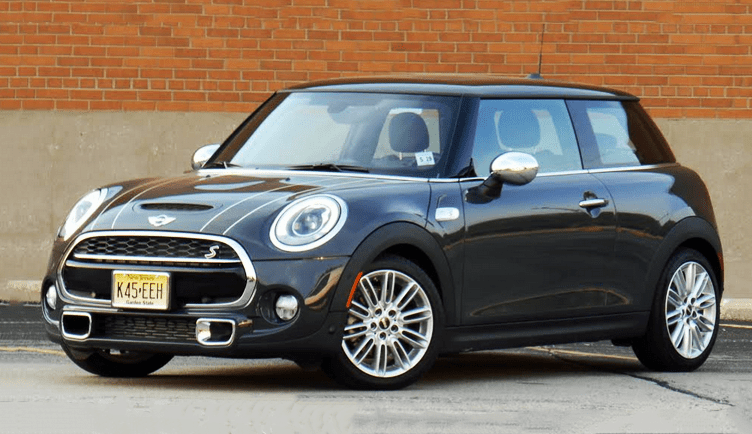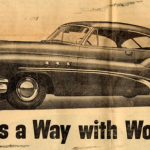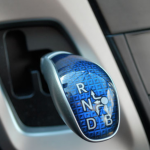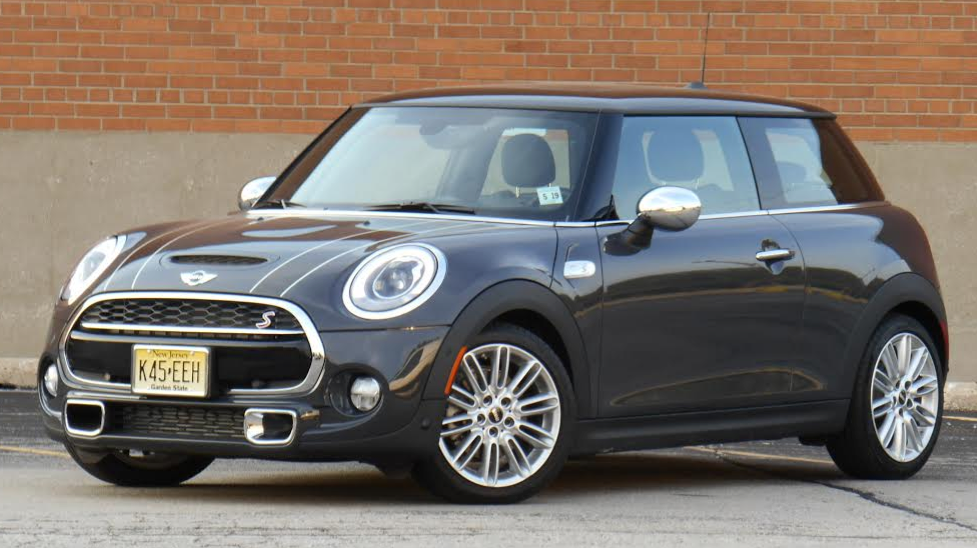
2014 Mini Cooper S Hardtop Automatic
Miles Driven: 210
Fuel Used: 7.8 gallons
Real-world fuel economy: 26.9 mpg
Driving mix: 60% city,40% highway
Base price: $23,600 (not including $795 destination charge)
Options on test car: Special color ($500), cloth/leather upholstery ($750), cold-weather package ($600), Fully Loaded package (includes navigation system, sunroof, premium audio system, $4500), special interior trim ($350), park-assist package ($1,000), automatic transmission ($1500), leather-wrapped steering wheel ($250), rear-view camera ($500), special chrome trim ($250), keyless entry ($250), auto-dimming mirrors ($500), Storage Package ($250), special headliner ($250), satellite radio ($300), dead-up display ($300), LED headlamp accents ($250)
Price as tested: $36,895
Quick Hits
The great: Great handling, lots of fun to drive
The good: Impressive fuel economy
The not so good: Cramped rear seat, high options prices
2014 Mini Cooper S
John Biel
For 2014, Mini kicks off a third generation of its 2-door hipsterwagen with a new platform, new engines, some added electronic gadgetry, a little more size, and modest appearance changes. It all adds up to a car you might like—or not like.
Here’s what one driver liked when he spent a few days with one of the new models:

- Acceleration, handling, and braking continue the Mini Cooper tradition of sporty, fun driving. The S version that came Consumer Guide®’s way had a 2.0-liter turbocharged 4-cylinder that puts out 189 horsepower and 207 lb-ft of torque. (This is a step up from the base Mini’s 1.5-liter turbo 3-cylinder rated at 134 horsepower and 165 lb-ft.) It was eager from a standstill and even more aggressive in highway passing. Quick, responsive steering and a solid structure made changes of direction play, not work.
- Among the new tech features is a choice of “Sport,” “Mid,” or “Green” driving modes that impact things like fuel delivery, steering, and transmission calibrations. The test car came with the optional 6-speed automatic transmission, which, when in Green mode, activates a coasting feature that disengages the transmission when your foot is off the gas. To this driver, it was not too obtrusive—certainly less so than the engine stop/start that a number of other cars use as a fuel-saving device.
- Speaking of fuel economy, the numbers from the Cooper S were not bad. A 122-mile stint yielded 28.88 premium-fueled mpg. That was with 64 percent of test miles under city conditions. EPA ratings for the car are 27 mpg in city driving and 38 on the highway.
- The Mini Cooper parallel parks like nobody’s business—even with 4.5 inches of added length and 1.7 inches of extra width for ’14. In fact, it will even do the job for you, provided you’ve got Park Assistant, another of the new technologies that’s available in a $1000 option package.
- Whatever Mini might have done to the face and flanks of the Cooper body, it left the roofline pretty much alone. That means good visibility all around from relatively tall windows and thin roof pillars.If you can make room for rear-seat passengers (more about that later), they will find comfortable seats and the same good head room that front-seat occupants enjoy in the boxlike body. The optional panoramic sunroof gives rear passengers their own shade, so it’s like having their very own sunroof.
- The speedometer and other key gauges have been moved from the center of the dash to in front of the driver. A round display with room for audio, navigation, and camera displays (as equipped) is now in the middle of the dash.
Here’s what that same driver didn’t like:
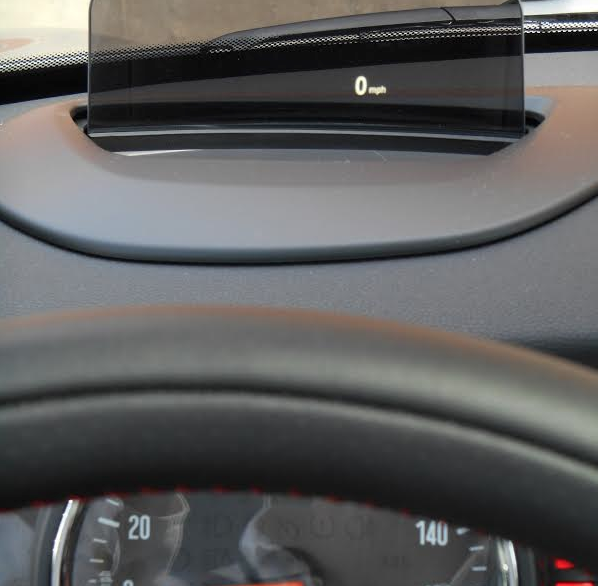
- The Cooper S was somewhat hard riding, and came off as a little pitchy over highway bumps.
- Tire noise was prominent at highway speeds.
- Front-seat construction is segmented, and portions of the cushion hit in odd places that you feel with some discomfort.
- With the new central controller on the console, it takes a lot of steps to select and save a radio station. Also, the gimmicky dividers between the toggle switches for things like the starter, traction control, etc., remain. These just get in the way.
- As noted, Mini has revamped its control layout. One curiosity is an LED band that encircles the round infotainment and systems display in the dash. This band changes color in response to things like engine speed, driving mode, audio volume, climate control, or interior lighting. If you’re of a certain age, we know what joke you’re about to make about this doo-dad, but Mini has beaten us to the punch—even it calls this a mood ring.
- The trip odometer in the instrument cluster doesn’t stay on. Within seconds of displaying trip mileage, it defaults to a digital speed readout—which appears right below the analog speedometer. Does one car really need 2 speedos? Or 3 if you order the head-up-display option? If you are intent on monitoring trip mileage, the more times you press the plunger to check, the more risk you run of accidentally zeroing out your trip information.
- Rear passengers probably will be cramped—in fact, they won’t fit at all if longer-legged front passengers need maximum room. Ingress and egress to the rear are difficult, too.
- Rear cargo space is just a week’s-groceries big, or weekend-getaway luggage-for-2 big. Rear seats fold, but they sit higher than the rear cargo floor. Space for incidentals in the cabin is slight, too.
The starting tab for the lively performing Mini Cooper S Hardtop is $23,600, but CG’s example neared $37,000 with delivery, so option-price creep might be another unlikeable thing about the car. Standards include a 6-speed manual transmission with rev-matching, cruise control, 16-inch alloy wheels, electronic brake-force distribution and corner brake control, firmly bolstered sport seats, a leather-wrapped steering wheel, configurable LED interior mood lighting, Bluetooth connectivity, USB port and iPod interface, 6-speaker audio, and fog lights.
As our test car showed, though, there’s a lot more available. The automatic trans added $1500. A “Fully Loaded Package” combined 3 option groups into one for $4500 to deliver items like navigation, the sunroof, automatic climate control, upgraded audio, and 17-inch wheels. (The 3 option groups can be ordered separately for more judicious cost management.) But even Fully Loaded doesn’t quite live up to its name—there’s plenty more to tack on for the buyer who wants it. If you like the Mini Cooper at all, you can make it into a car that you really like.
Rick Cotta
Some additions and counter points to John’s (excellent) notes:

- Cooper hatchbacks have previously had a virtually useless back seat for adults unless the front-seaters were very short; even kids would have a tough time back there unless they were just the right size (legs long enough for knees to bend over the seat cushion, not too long for knees to hit the seat back ahead). This redesigned and somewhat larger edition is slightly better in this regard, as my 5’9 frame could “sit behind itself” – though just barely. And I didn’t find it particularly hard to get to the back seat, as the door opening is fairly tall.
- Interior storage is quite good. There’s a decent-sized lower glovebox, a “secret” upper glovebox (you have to know to press on the panel to open it; there’s no button), a tiny bin in the adjustable-height armrest, a forward console bin with USB/Aux/12-volt plugs, two console cupholders, and map pockets in the doors.
- There’s a fair amount of cargo storage, but the fact that folding the rear seat backs leaves them resting a few inches above the level of the cargo floor makes it difficult to slide in large objects.
- Coopers have always had an odd and somewhat inconvenient instrument and control layout, and this new model is no different. Well, it’s different, but not really any better … at least, not in our loaded, nav-equipped test vehicle. Retained are Mini’s signature steering-column-mounted instrument pod, circular center-dash display, and row of lower-dash toggle switches, but they’ve all been reconfigured and repurposed. It used to be that the tachometer was in a pod directly in front of the driver, and it could be programmed to include a digital speedometer within its face; meanwhile, the “regular” analog speedometer was in the large circular panel in the center of the dashboard. (Unless you got the optional navigation system, which moved the speedo to a separate pod in front of the driver.) Now, however, the speedo is the main gauge in front of the driver, with the tachometer being a small “eyebrow” off to the left side. And speaking of speedometers, our test car had three – all within a hand-span of each other. There was the round analog one, a digital one in its face, and a third in the pop-up head-up display panel atop the dash (optional at extra cost).
- Center-stack controls in the Mini have always been quirky, the layout trading functionality for some kind of retro styling theme. Same goes for the new car. At least in our nav-equipped test vehicle, the “center circle” was taken up mostly by a large, non-touch screen, with basic audio controls (on/off/volume knob and station-select buttons) beneath it. Below that are three climate-control dials, and though fan speed and temp are rotary adjustments, mode is by tedious repetitive-step pushbutton. Beneath those is a row of buttons for things like seat heaters, and down at the bottom are the trademark toggle switches, which now include a “start” flipper (as opposed to a conventional starter button). Many settings are buried deep in menus that take time – and guesswork – to access. Granted, most of these controls will become second nature after a while, but some still won’t be handy. (What was handy, however, was the — gasp — trip reset stalk, sitting right out there on the IP where heaven intended.)

- New is the console control knob. It incorporates some audio functions along with nav, phone, and multi-media functions, with displays showing up on the dashboard screen. As with all such controllers, its position near your right thigh requires a long look from the road to adjust.
- The Cooper has long been one of the few cars whose sunroof opening goes far enough forward for me to see sky while I’m driving. I really like that, though I’d like it more if the opening were wider. Visibility has long been, and continues to be, a Mini strong suit. Which I also appreciate.
- Dynamically, it seems the Cooper – at least in S form – has matured somewhat. Whereas the previous edition almost totally eschewed ride comfort for exemplary steering and handling precision, the current generation moves the needle a bit toward the “ride” side of the equation. As such, the S doesn’t feel quite as sharp in quick changes of direction, but it’s far more livable over any kind of pavement imperfection. Overall, that’s probably a solid move on Mini’s part, as the likely to-be-revived John Cooper Works sport model can be aimed at the hardcore performance freaks. And this is still one great-handling car, and still about as close as you can get to a street-legal go cart.
- The only fly in the dynamic ointment was that the car’s automatic transmission sometimes seemed to get caught between gears when the throttle was applied at low speeds, such as after rounding a tight corner. It would just coast for a moment and then suddenly start pulling. This, of course, can be nullified if you get the manual transmission this car so richly deserves.
Although I had hoped the redesign would bring a few more “civilities” – notably to the control layout – overall, this seems to be an improvement for the mass market. And it’s possible a lower-line model with less in the way of options (and resulting cost) would have been more to my liking. But the 2012 Mini Cooper S remains on my personal “Most Wanted” list, because it’s really hard to have more fun behind the wheel.
2014 Mini Cooper S
2014 Mini Cooper S
2014 Mini Cooper S

